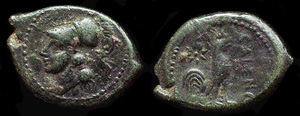Cales on:
[Wikipedia]
[Google]
[Amazon]
 Cales was an ancient city of
Cales was an ancient city of
 Cales was an ancient city of
Cales was an ancient city of Campania
Campania is an administrative Regions of Italy, region of Italy located in Southern Italy; most of it is in the south-western portion of the Italian Peninsula (with the Tyrrhenian Sea to its west), but it also includes the small Phlegraean Islan ...
, in today's ''comune
A (; : , ) is an administrative division of Italy, roughly equivalent to a township or municipality. It is the third-level administrative division of Italy, after regions () and provinces (). The can also have the City status in Italy, titl ...
'' of Calvi Risorta in southern Italy
Italy, officially the Italian Republic, is a country in Southern Europe, Southern and Western Europe, Western Europe. It consists of Italian Peninsula, a peninsula that extends into the Mediterranean Sea, with the Alps on its northern land b ...
, belonging originally to the Aurunci/ Ausoni, on the Via Latina.
The Romans captured it in 335 BC and established a colony with Latin rights of 2,500 citizens. Cales was initially the centre of the Roman dominion in Campania. To the period after 335 belong numerous silver and bronze coins with the inscription ''Caleno''. It was an important base in the war against Hannibal
Hannibal (; ; 247 – between 183 and 181 BC) was a Punic people, Carthaginian general and statesman who commanded the forces of Ancient Carthage, Carthage in their battle against the Roman Republic during the Second Punic War.
Hannibal's fat ...
, and at last refused further contributions for the war. Before 184 BC more settlers were sent there. After the Social War it became a ''municipium''. The fertility of its territory and its manufacture of black glazed pottery
Pottery is the process and the products of forming vessels and other objects with clay and other raw materials, which are fired at high temperatures to give them a hard and durable form. The place where such wares are made by a ''potter'' is al ...
, which was even exported to Etruria, made it prosperous. At the end of the 3rd century BC it appears as a colony, and in the 5th century (AD) it became an episcopal see
An episcopal see is the area of a bishop's ecclesiastical jurisdiction.
Phrases concerning actions occurring within or outside an episcopal see are indicative of the geographical significance of the term, making it synonymous with ''diocese'' ...
, which (jointly with Tano since 1818) it still is, though it is now a mere village. The cathedral
A cathedral is a church (building), church that contains the of a bishop, thus serving as the central church of a diocese, Annual conferences within Methodism, conference, or episcopate. Churches with the function of "cathedral" are usually s ...
, of the 12th century, has a carved portal and three apse
In architecture, an apse (: apses; from Latin , 'arch, vault'; from Ancient Greek , , 'arch'; sometimes written apsis; : apsides) is a semicircular recess covered with a hemispherical Vault (architecture), vault or semi-dome, also known as an ' ...
s decorated with small arches and pilaster
In architecture, a pilaster is both a load-bearing section of thickened wall or column integrated into a wall, and a purely decorative element in classical architecture which gives the appearance of a supporting column and articulates an ext ...
s, and contains a fine pulpit
A pulpit is a raised stand for preachers in a Christian church. The origin of the word is the Latin ''pulpitum'' (platform or staging). The traditional pulpit is raised well above the surrounding floor for audibility and visibility, accesse ...
and episcopal throne in marble mosaic
A mosaic () is a pattern or image made of small regular or irregular pieces of colored stone, glass or ceramic, held in place by plaster/Mortar (masonry), mortar, and covering a surface. Mosaics are often used as floor and wall decoration, and ...
. Near it are two grottos, which have been used for Christian
A Christian () is a person who follows or adheres to Christianity, a Monotheism, monotheistic Abrahamic religion based on the life and teachings of Jesus in Christianity, Jesus Christ. Christians form the largest religious community in the wo ...
worship and contain frescoes of the 10th and 11th centuries. cites: E. Bertaux, ''L'Art dans l'Italie méridionale'' (Paris, 1904), i. 244, &c. Inscriptions name six gates of the town: and there are considerable remains of antiquity, especially of an amphitheatre and theatre, of a supposed temple, and other edifices.
A number of tombs belonging to the Roman necropolis were discovered in 1883.
See also
* Aurunca, another city of the Ausones/Aurunci * Ausona (ancient city), another city of the Ausones/Aurunci * Coinage of CalesReferences
Attribution: * {{Authority control Roman sites of Campania Former populated places in Italy Archaeological sites in Campania Roman towns and cities in Italy